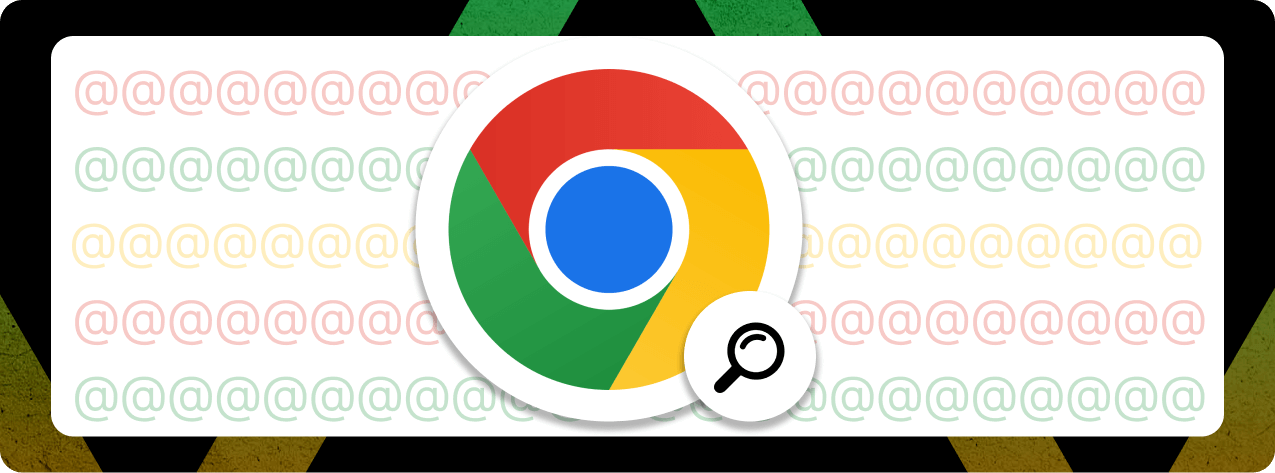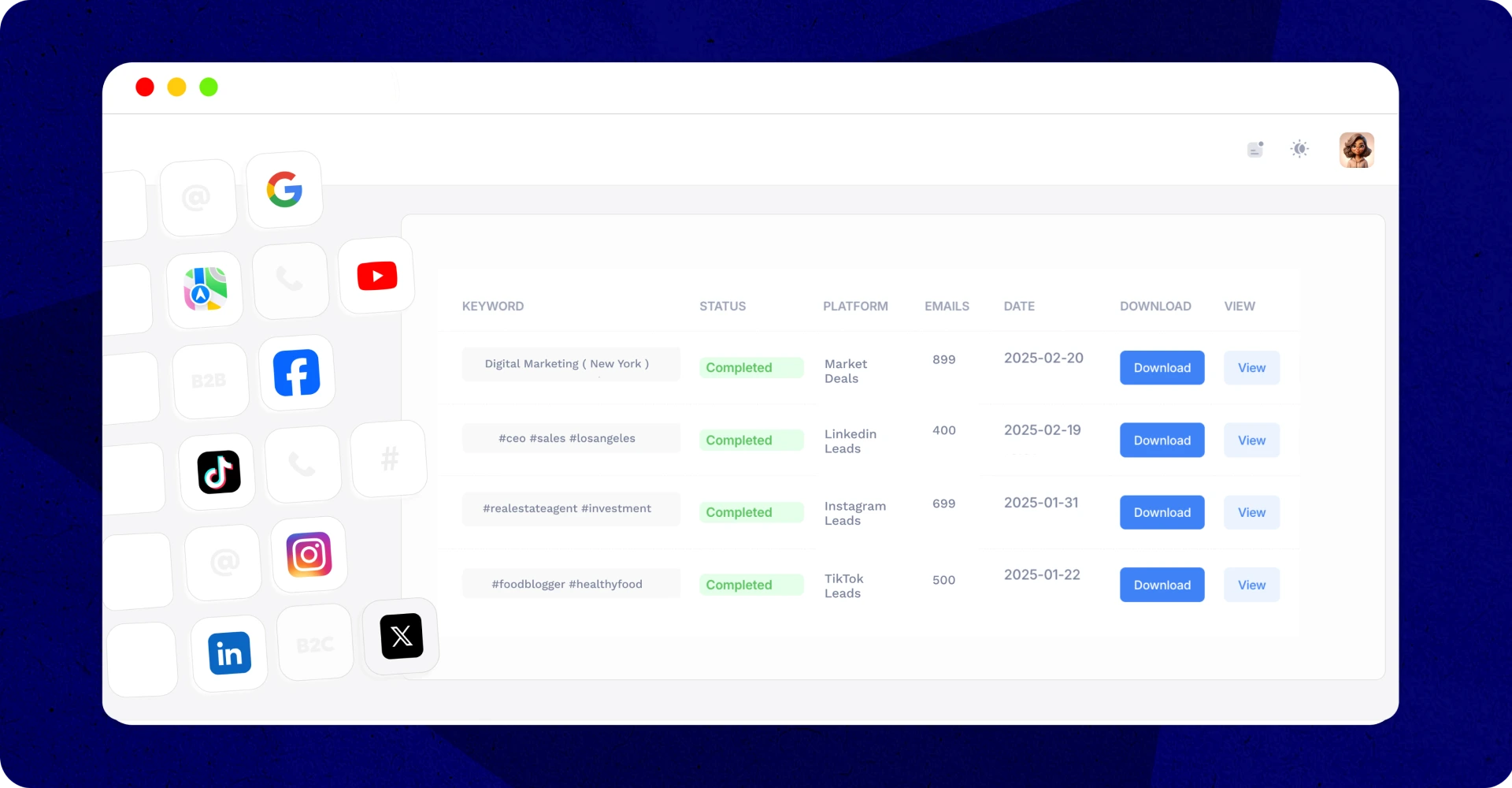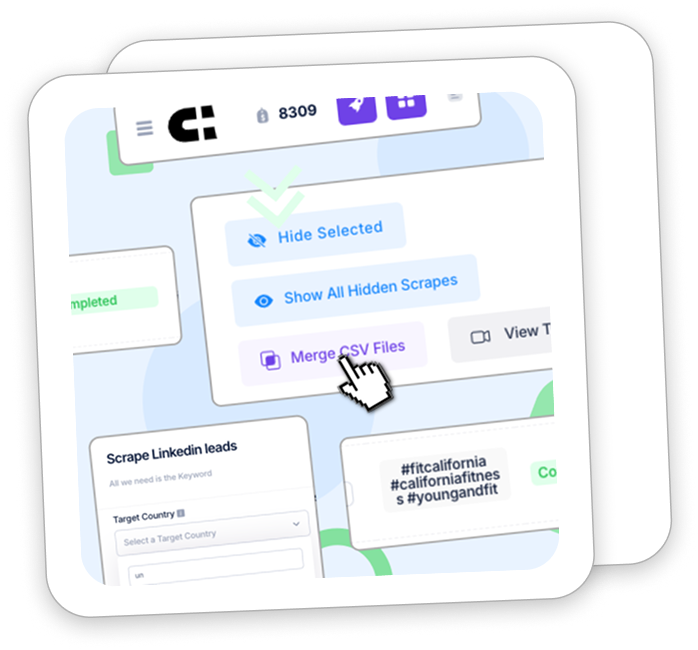Email Scraper Chrome: The Ultimate Tool for Extracting Email Addresses

Let’s be real: manually hunting for email addresses online is a waste of time. Copy, paste, repeat… for hours. No thanks. Smart marketers, freelancers, and sales pros don’t do that anymore. They use tools like IGLeads or a Chrome email scraper to pull emails straight from websites in seconds.
No coding. No guesswork. Just click, scrape, and you’ve got a lead list ready to roll. Whether you’re cold emailing, pitching, or growing your network, this is how you do it at scale, without the headache. IGLeads lets you go even further, pulling not just emails from websites but also from platforms like Instagram, Google Maps, LinkedIn, and more: All in one dashboard.
In this guide, I’ll show you how Chrome email scrapers work, how to use them properly, and why tools like IGLeads take your lead generation to the next level.
How to Use a Chrome Email Scraper for Efficient Lead Generation
Email scraper chrome is a powerful chrome extension that allows users to extract email addresses from websites quickly and efficiently. This tool has become increasingly popular among professionals who rely on email marketing campaigns to reach their target audience. With email scraper chrome, users can easily gather contact information from potential clients and customers, allowing them to expand their reach and increase their sales.
One of the key benefits of email scraper chrome is its ease of use. The extension is user-friendly and can be installed with just a few clicks. Once installed, users can simply navigate to a website and click on the extension to extract all the email addresses on that page. This saves users valuable time and effort that would otherwise be spent manually searching for contact information.
Overall, email scraper chrome is a valuable tool for anyone looking to expand their email marketing efforts. Its ability to quickly and efficiently extract email addresses from websites makes it an essential tool for professionals in a wide range of industries.
Understanding Email Scrapers
What Is an Email Scraper?
An email scraper is a tool that extracts email addresses from various sources on the internet. These sources can include websites, social media platforms, and online directories. The email scraper works by crawling through the web pages and collecting email addresses that are publicly available.
Email scrapers are commonly used by businesses and individuals for marketing and outreach purposes. They can help increase the size of an email list quickly and easily, allowing for more effective email campaigns.
Benefits of Using Email Scrapers
Using an email scraper can provide several benefits for businesses and individuals. One of the main benefits is that it can save time and effort in collecting email addresses manually. Email scrapers can quickly extract a large number of email addresses from various sources, which would be difficult to do manually.
Another benefit of using an email scraper is that it can help businesses and individuals reach a wider audience. By collecting email addresses from different sources, they can target potential customers who may not have been reached through other marketing channels.
Common Features of Email Scrapers
Email scrapers can vary in features and capabilities, but there are some common features that are found in most email scraper tools. These features include:
- Keyword search: Email scrapers can search for specific keywords related to the business or industry to find relevant email addresses.
- Filter options: Email scrapers can filter out irrelevant email addresses based on criteria such as domain name or location.
- Export options: Email scrapers can export the collected email addresses into various file formats such as CSV, TXT, or Excel.
Overall, email scrapers can be a valuable tool for businesses and individuals looking to expand their email lists and reach a wider audience. However, it is important to use email scrapers ethically and responsibly, and to comply with any applicable laws and regulations regarding email marketing.
Choosing the Right Email Scraper for Chrome
Key Considerations
When choosing an email scraper for Chrome, there are several key considerations to keep in mind. First and foremost, it is important to ensure that the scraper you choose is compatible with the Chrome browser. Additionally, you should consider the level of customization and control you require over your scraping process. Some email scrapers offer more advanced settings and options, while others are more straightforward and user-friendly.
Another important consideration is the size and quality of the email database that the scraper can provide. Look for a scraper that can provide a large and diverse database of high-quality emails. Additionally, consider the level of accuracy and reliability that the scraper can offer. It is important to choose a scraper that can provide accurate and up-to-date information, as outdated or incorrect information can harm your business.
Top Email Scraper Extensions
There are several popular email scraper extensions available for Chrome, each with its own unique features and capabilities. Some of the most popular options include:
| Extension | Key Features | Price |
|---|---|---|
| Hunter.io | Find and verify emails directly from your browser. Includes a powerful search algorithm and a 200M+ email database. | Free to $399/month |
| GetProspect | Find and verify emails, phone numbers, and social media profiles. Designed for lead generation. | $49 to $399/month |
| FindThatLead | Email verification, domain search, and LinkedIn prospecting. | Free to $399/month |
| Skrapp.io | Find and verify emails from LinkedIn and websites. Offers customization and advanced settings. | Free to $49/month |
| Clearout | Provides email verification and validation to improve deliverability and avoid spam. | $75 to $2,500/month |
| Uplead | Email verification, contact search, and company information lookup for lead generation. | $99 to $399/month |
| Wiza | Find and verify emails from LinkedIn. Also gathers phone numbers and job titles. | $50 to $200/month |
Keep in mind that the best email scraper for you will depend on your specific needs and budget. Consider the features and pricing of each option carefully before making a decision.
Installation and Setup
How to Install an Email Scraper Extension
Installing an email scraper extension on Chrome is a simple process. First, navigate to the Chrome Web Store and search for the email scraper extension of your choice. Once you have found the extension, click on the “Add to Chrome” button.
After clicking on the button, a pop-up window will appear asking for confirmation to add the extension. Click on “Add extension” to proceed with the installation. The extension will be added to your browser and you can start using it right away.
Configuring Email Scraper Settings
Once the email scraper extension is installed, you can configure its settings to suit your needs. To access the configuration settings, click on the extension icon in the Chrome toolbar and select “Options”.
In the options menu, you can set the maximum number of emails to scrape per page, the maximum number of pages to scrape, and the delay time between each scrape. You can also choose to exclude certain domains or email addresses from the search.
It is important to note that some email scraper extensions may have different configuration options, so it is recommended to read the documentation or user guide provided by the extension developer.
In summary, installing and configuring an email scraper extension on Chrome is a straightforward process. By following the steps outlined above, users can easily set up an email scraper and customize it according to their preferences.
Using Email Scrapers Effectively
Step-by-Step Guide to Scraping Emails
To use email scrapers effectively, it is important to follow a step-by-step guide. The first step is to identify the target web page from which you want to extract email addresses. Once you have identified the web page, open it and visit the page using a web browser.
Next, you need to install an email scraper chrome extension. There are many email scraper chrome extensions available, but it is important to choose one that is easy to use and provides accurate results. Once you have installed the extension, open it and select the web page you want to scrape.
After selecting the web page, you need to configure the email scraper according to your requirements. This includes setting up advanced filters to ensure that you get accurate results. Once you have configured the email scraper, start the scraping process.
The email scraper will extract email addresses from the web page and export them to a CSV file. It is important to review the results and remove any duplicate or invalid email addresses.
Advanced Techniques and Tips
To get the most out of email scrapers, it is important to use advanced techniques and tips. One advanced technique is to use multiple email scrapers to extract email addresses from different web pages. This can help you build a comprehensive email list.
Another advanced technique is to use confidence scores to filter out low-quality email addresses. Confidence scores are a measure of the accuracy of the email address. Email scrapers that provide confidence scores can help you avoid wasting time on low-quality email addresses.
It is also important to use advanced filters to ensure that you get accurate results. Advanced filters can help you target specific email addresses based on criteria such as domain name, job title, and location.
Avoiding Common Pitfalls
When using email scrapers, it is important to avoid common pitfalls. One common pitfall is to scrape too many web pages at once. This can lead to inaccurate results and can also get your IP address blocked by the web server.
Another common pitfall is to rely too heavily on email scrapers. Email scrapers are a useful tool, but they should not be the only tool you use to build an email list. It is important to supplement your email list with other sources such as social media and networking events.
Finally, it is important to respect the privacy of individuals whose email addresses you are scraping. Make sure to comply with all relevant laws and regulations, and only use email addresses for legitimate purposes.
Overall, email scrapers can be a powerful tool for building an email list. By following a step-by-step guide, using advanced techniques and tips, and avoiding common pitfalls, you can use email scrapers effectively and efficiently.
Email Verification and Validation
Importance of Email Verification
Email verification is a crucial step in maintaining a clean and accurate email list. It ensures that all email addresses on the list are valid and active, reducing the chances of bounce backs and increasing deliverability rates.
Verified email addresses also help in reducing the bounce rate, which is an important metric for email marketing campaigns.
Tools for Real-Time Email Verification
There are several tools available for real-time email verification, which can be integrated with email scraper chrome extensions. These tools help in validating email addresses in real-time, ensuring that only valid email addresses are added to the list.
They also help in reducing the bounce rate and improving the deliverability rates of email campaigns.
Maintaining Email List Accuracy
Maintaining email list accuracy is crucial for the success of email marketing campaigns. Regularly cleaning the email list and removing invalid and inactive email addresses can help in improving the accuracy of the list. It also helps in reducing the bounce rate and improving the deliverability rates of email campaigns.
To maintain the accuracy of the email list, it is important to use email verification tools and regularly clean the list. This ensures that the email list remains accurate and up-to-date, improving the chances of success for email marketing campaigns.
Integrations and Automation
CRM and API Integrations
Integrating an email scraper with a CRM system can help streamline the process of managing and organizing the scraped data. With API integrations, users can easily transfer the scraped data to their CRM system without any manual effort. This not only saves time but also ensures accuracy and consistency of the data.
Users can also integrate the email scraper with other APIs to expand its functionality and automate tasks. For instance, integrating with a marketing automation tool can help users automate their email marketing campaigns and improve their overall efficiency.
Automating the Email Scraping Process
Automating the email scraping process can help users save time and effort. With automation, users can set up the scraper to run at specific intervals and scrape data from multiple sources automatically. This eliminates the need for manual intervention and ensures that the data is always up-to-date.
Users can also automate the process of exporting the scraped data to their preferred format, such as CSV or Excel. This can be done using automation tools like Zapier, which can help users automate the entire process from scraping to exporting the data.
Using Webhooks and Zapier
Webhooks and Zapier can be used to automate the entire email scraping process. With webhooks, users can set up triggers that automatically send data to their preferred destination, such as a CRM system or marketing automation tool.
Zapier, on the other hand, can be used to automate the entire process from scraping to exporting the data. Users can set up triggers that automatically scrape data from multiple sources and export it to their preferred format.
Overall, integrating an email scraper with other tools and automating the process can help users save time and effort while ensuring accuracy and consistency of the data. With the right integrations and automation tools, users can streamline their email scraping process and improve their overall efficiency.
Legal and Ethical Considerations
Understanding the Legality
Email scraping is a practice that can be legally challenging. The legality of email scraping depends on the context in which it is used. In some cases, email scraping can be considered illegal and can result in legal consequences. For instance, scraping emails from websites that have explicit rules against it or from individuals who have not given their consent can be considered illegal. Therefore, it is important to understand the legal implications of email scraping before engaging in the practice.
Best Practices for Compliance
To avoid legal issues, it is important to follow best practices for compliance. This includes obtaining explicit consent from individuals before scraping their emails, ensuring that the emails being scraped are publicly available, and respecting websites’ terms of service. Additionally, it is important to keep records of the consent given by the individuals whose emails are being scraped.
Respecting Privacy and Relationships
Email scraping can also raise privacy concerns. It is important to respect the privacy of individuals whose emails are being scraped. This includes ensuring that their personal information is not being misused or shared without their consent. Additionally, it is important to maintain a positive relationship with the individuals whose emails are being scraped.
This can be achieved by providing them with relevant and valuable content, and by giving them the option to opt-out of future emails.
In conclusion, email scraping can be a useful tool for businesses and individuals, but it is important to understand the legal and ethical considerations involved. By following best practices for compliance and respecting privacy and relationships, email scraping can be used in a responsible and effective manner.
Maximizing Outreach and Engagement
Building Targeted Email Lists
The success of any email outreach campaign depends on the quality of the email list. The first step in building a targeted email list is to identify the target audience. This can be done by researching the industry, analyzing competitors, and understanding the needs of potential customers.
Once the target audience is identified, the next step is to gather contact information. This can be done using an email scraper chrome extension, which can extract email addresses from websites and social media platforms. It’s important to ensure that the email addresses collected are valid and up-to-date to avoid bounce rates and spam complaints.
Crafting Effective Outreach Campaigns
Crafting an effective outreach campaign involves creating personalized and engaging content that resonates with the target audience. This can be achieved by segmenting the email list based on demographics, interests, and behavior. Personalization can also be enhanced by using merge tags, which allows for the inclusion of the recipient’s name and other relevant information.
In addition to personalized content, the email should have a clear call-to-action (CTA) that encourages the recipient to take action. The CTA should be prominent and easy to understand, and should lead the recipient to a landing page that is relevant to the email content.
Measuring Engagement and Success
Measuring engagement and success is essential to optimizing future outreach campaigns. Metrics such as open rates, click-through rates, and conversion rates can provide valuable insights into the effectiveness of the campaign.
To improve engagement and success, it’s important to analyze the data and make adjustments accordingly. This can involve tweaking the subject line, changing the content, or adjusting the CTA. A/B testing can also be used to test different variables and determine what works best for the target audience.
Overall, building a targeted email list, crafting effective outreach campaigns, and measuring engagement and success are key to maximizing outreach and engagement. By following these best practices, businesses can improve their sales prospecting efforts and achieve their outreach goals.
Exploring Additional Features
Supplementary Tools and Extensions
Email scraper chrome is a powerful tool for extracting email addresses from websites. However, there are several supplementary tools and extensions that can enhance its functionality and make it even more useful. One such tool is the “Email Extractor” extension, which allows users to extract email addresses from web pages with a single click.
Another useful tool is the “Email Hunter” extension, which allows users to search for email addresses based on specific criteria, such as domain name or keyword. This can be particularly useful for businesses looking to target specific industries or niches.
Enhancing Functionality with Additional Features
In addition to these supplementary tools and extensions, there are several additional features that can be used to enhance the functionality of email scraper chrome. These features include the ability to extract email addresses from multiple pages at once, the ability to filter results based on specific criteria, and the ability to export results in a variety of formats.
One particularly useful feature is the ability to extract email addresses from PDF files. This can be particularly useful for businesses that receive a lot of resumes or other documents in PDF format.
Overall, email scraper chrome is a powerful tool for extracting email addresses from websites. By using supplementary tools and extensions and taking advantage of additional features, users can enhance its functionality and get even more value from this powerful tool.
Why IGLeads Doesn’t Need a Chrome Extension
Unlike most Chrome email scrapers that only pull emails from the websites you manually visit, IGLeads works entirely from the cloud. You don’t need to install anything, open hundreds of tabs, or scrape one page at a time.
IGLeads pulls data directly from multiple platforms, including:
-
- Instagram: Find creator emails, business contacts, and niche leads.
- Google Maps: Get emails, phone numbers, and business info from local companies anywhere in the world.
- LinkedIn:: Scrape decision-makers’ contact details, job titles, and company information.
- YouTube: Extract creator and channel owner emails for sponsorships, collaborations, or outreach.
- TikTok: Find influencer and business emails from TikTok profiles for influencer marketing or outreach.
- Twitter: Scrape emails and contact info from public Twitter profiles and accounts in any niche.
- Real Estate Scraper: Access property owner data including emails, phone numbers, addresses, absentee owners, vacant homes, and more—perfect for investors, agents, and wholesalers.
Whether you’re a freelancer, agency, or business owner, IGLeads gives you the ability to generate leads at scale, faster and more efficiently than any Chrome-based tool.
Frequently Asked Questions
Email scraping is legal when you’re collecting publicly available information and using it responsibly. However, it’s important to comply with privacy laws like GDPR, CAN-SPAM, and respect website terms of service. Always use scrapers ethically and for legitimate outreach purposes.
No, email scrapers are most effective on websites where emails are publicly visible. Some websites hide email addresses behind contact forms or JavaScript, which can limit what the scraper can extract unless the tool supports advanced parsing like IGLeads.
Accuracy depends on the tool’s capabilities. While Chrome email scrapers can grab visible emails instantly, it’s recommended to verify the emails using built-in validation tools or third-party verifiers to reduce bounces and improve deliverability.
A Chrome email scraper pulls emails from web pages you visit manually. IGLeads goes further—it automates email extraction from platforms like Instagram, Google Maps, LinkedIn, and YouTube at scale, all from a single dashboard, without requiring manual browsing.
Most Chrome scrapers are semi-automated—you need to visit each page manually. However, tools like IGLeads offer full automation, plus CRM integrations and bulk scraping, making it more scalable for larger prospecting tasks.


